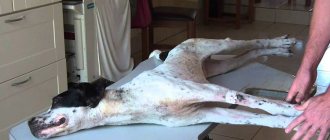Animals, including dogs, are susceptible to many different diseases with a variety of symptoms. To prevent negative consequences, the most thorough study of the problem is required, a detailed clarification of all its features, as well as the measures that need to be taken in case of a certain disease. In addition to parasitic problems such as mange, mites, shedding and fleas, which are the most common diseases, breeders often encounter such a frightening phenomenon as seizures in dogs.
They look very scary - the dog suddenly falls to the ground, shakes in convulsions, and involuntarily twitches its paws. Sometimes even experienced dog owners who have never experienced seizures before become frightened and panic. However, panic is unacceptable here. A dog can only be helped if immediate and adequate measures are taken. Let's look at the reasons why dogs have seizures and what needs to be done if they start.
What are seizures and how do they occur in dogs?
A cramp is a sudden, involuntary contraction of muscle tissue. The process cannot be understood and is not controlled.
Very often, owners who encounter the problem for the first time are not able to recognize the onset of an attack. If a dog’s seizures are regular, the owner can remember the warning signs and provide the pet with the necessary help.
Stages of attack:
- Aura - the initial stage can last from a few minutes to 1-2 days. During this period, the dog behaves restlessly. Whimpers, trembles, looks for a secluded place. Sometimes pets refuse food and water. A harbinger of an imminent attack is trembling of the limbs and the tip of the tail.
- The main blow usually the condition does not have a preparatory stage. The whole process occurs rapidly and requires urgent intervention from the owner. Characteristic signs of seizures: involuntary contraction (tension) of the muscles of the hind and forelimbs, back, neck or abdomen. The dog does not move its paws, falls to the side, clenches its jaws tightly. Sometimes involuntary urination occurs. During severe convulsions, saliva or foam flows from the mouth. The duration of the attack is from 1 to 10 minutes.
- The post-traumatic period is the stage of muscle relaxation. The pet whines, groans, staggers. Disorientation in space, absent-mindedness and apathy are often observed. The duration of the stage is from 1 hour to 1 day.
Experienced owners can prevent or reduce seizures at an early stage. Therefore, it is important to closely monitor animals that are predisposed to seizures and spasms.
Classification
- Convulsions : short-term contractions of individual muscles. The dog reacts to sounds. Externally, convulsions can be almost invisible or look like twitching. These are mild spasms that are rarely accompanied by severe pain. Such contractions are characteristic of psychological disorders, poisoning, neurology, brain injuries, stress or sudden changes in temperature. Duration from 2–3 seconds to 5–10 minutes . The attacks may be repeated several times a day or vary in nature.
- Tonic seizures are characterized by short, localized contractions. Sharp spasms cause severe pain and anxiety for the dog. Outwardly it looks like twitching of a certain group of muscles with equal pauses. The animal is conscious during an attack, whines, refuses food, and attention is distracted. Spasms do not harm your pet’s health, but the reason why they occur can be quite serious: cardiovascular disease, viral infection, poisoning, stress, hypothermia, heat stroke, diabetes, kidney failure.
- Clonic seizures : brief but quite severe spasms that may be accompanied by falling, loss of consciousness and disorientation. The spasm can be repeated with a pause of 20 seconds to 4 minutes . During the rest period, the dog regains consciousness and tries to get up. The duration of the spasm is from 2 to 10 minutes . The causes of spasms can be prolonged stress, intense exercise, infections, overheating, viral diseases, traumatic brain injuries, oncology, and neurological disorders.
- An epileptic seizure is an extremely dangerous type of seizure. Strong and sudden contractions affect all the muscles of the animal. The dog has spasms, loses consciousness and falls. During a seizure, saliva flows, foam flows, the muscles in the crane are tense, the jaws are clenched. Sometimes dogs cannot close their eyes during a convulsion; the pupils are dilated and do not respond to external stimuli. The attack is accompanied by severe pain throughout the body. The cause is congenital or acquired epilepsy. The duration of the attack is from 2 to 6 minutes. After a seizure, the pet does not immediately come to its senses. Rapid breathing, attempts to rise, loss of balance and lethargy are noted.
Epilepsy is incurable, but with proper care and timely therapy, spasms can be weakened and minimized.
A localized type of cramp affects small areas of tissue and affects only one muscle group. But if a dog has seizures throughout the body and affects more than 1 group, then this is a generalized type .
Prescription drugs
Your veterinarian may prescribe one or more antiseizure medications to control your dog's seizures:
- Phenobarbital
- Potassium bromide (KBr)
- Primidon
- Imepitoin
- Zonisamide
- Keppra (levetiracetam)
For many dogs, antiseizure therapy goes through a period of trial and error. Medications can be combined, adjusted, or changed until your dog's seizures stop.
In many cases, laboratory tests must be performed regularly to monitor your dog's response to medications and overall health.
Never change your dog's medications without specific instructions from your veterinarian. Communication with your veterinarian is vital, and it is important that you adhere to their recommendations if you want treatment to be successful. With care and attention, your dog can live a long, healthy life despite occasional seizures.
Causes
Often, seizures are caused by illness or genetic changes in the animal's body. The task of the owner and veterinarian is to find out the reason why the dog has seizures and prescribe the correct treatment. Timely therapy helps eliminate the cause or reduce the strength and number of contractions.
Psychological
Overexcitement, fear and stress are common causes of seizures in puppies, older animals and small breed dogs. Spasms and trembling can also occur in large but impressionable individuals. Such symptoms often occur at a doctor’s appointment, during a thunderstorm, or when meeting new people.
Hyperactive and impressionable dogs require increased attention and care . It is necessary to remove the irritant that is a source of fear or stress. It is necessary to socialize the pet and accustom it to a new environment. Active games and proper nutrition help dogs. Sometimes veterinarians prescribe sedatives and a course of vitamins.
Infectious and viral diseases
Hypertonicity of muscle tissue can develop against the background of viral, fungal and infectious diseases. In addition to specific symptoms, the diseases are characterized by damage to the central nervous system and convulsive muscle contractions. In this case, it is necessary not only to reduce tissue tone, but to fight the underlying cause.
Diseases that are accompanied by seizures:
- rabies;
- infectious enteritis;
- carnivore plague;
- hepatitis;
- pyelonephritis;
- meningitis;
- leptospirosis;
- encephalitis.
These are not all diseases that are accompanied by spasms and convulsions. Most diseases are incurable. To protect your pet from the disease, it is necessary to vaccinate and undergo preventive examinations at a veterinary clinic.
Metabolic disease
Often, seizures develop against the background of metabolic disorders, as well as a deficiency of certain substances. Associated symptoms: thirst, indigestion, obesity, exhaustion, problems with hair and skin.
Causes:
- Eclampsia is a condition that develops from acute calcium deficiency. Miniature breed dogs usually suffer from the disease. Pregnant and lactating dogs are at risk.
- Diabetes mellitus is characterized by unstable glucose levels. A sharp drop in sugar levels can lead to loss of consciousness, prolonged coma and death of the dog. Elevated levels affect the functioning and condition of internal organs, the brain and metabolism. In the absence of control, diet and treatment, the animal dies.
- Obesity or exhaustion can also be causes of convulsive contractions.
Treatment: diet, diet correction, training, vitamins, mineral supplements. If you have diabetes, you may need regular blood sugar monitoring and insulin therapy.
Traumatic
In some cases, seizures develop due to injury to the dog.
Injuries:
- limbs;
- spine;
- cranial;
- electrical injuries;
- failure of internal organs.
Sometimes involuntary contractions can manifest themselves the very next day. But it happens that post-traumatic seizures occur after a month or a year.
Some owners notice that their dog twitches in his sleep like convulsions. But this has nothing to do with muscle spasms. Most likely, your pet is having an interesting dream about chasing, hunting or playing. Muscle tremors, sudden contractions and twitching during sleep are the norm for dogs.
If convulsions recur periodically and then disappear, this does not mean that the disease has receded. Perhaps the disease has moved to another stage. You should not let the development of such a dangerous symptom take its course. It is necessary to consult a doctor and begin treatment.
Hind leg cramps
Muscle spasms of the hind limbs can be a complication after illness and surgery.
Common reasons:
- cardiovascular diseases;
- renal and liver failure;
- asphyxia;
- spinal or brain cancer;
- degenerative myelopathy;
- postoperative complications;
- reaction to medications;
- allergy;
- state after anesthesia.
If treatment is not started, the disease will progress. This will lead to paralysis, and in particularly difficult cases, death of the dog.
Why do muscles cramp?
The reasons can be divided into two groups. The first includes those that do not have any underlying diseases. So, if the calf or gluteal muscles cramp in a dream, there is no physiological pathology in this. The seizure in this case is a parasomnia, that is, a phenomenon associated with sleep. Spasms that occur during increased physical activity also do not indicate an abnormality.
In other cases, such discomfort may be caused by:
- neurological disorders;
- compaction of muscle fibers against the background of physical inactivity;
- metabolic disorders;
- micronutrient deficiency;
- dehydration;
- poisoning (including cramps from a hangover).
There is also a disease called hypoparathyroidism. It is characterized by a convulsive syndrome that immediately affects muscle groups. This condition is caused by hypofunction of the parathyroid glands.
Convulsions and foaming at the mouth in a dog
Convulsive spasms most often accompany diseases such as eclampsia, epilepsy, diabetes mellitus (hypoglycemia), and tumors. Convulsions and foam can also occur due to poisoning, severe infestation, allergies to drugs and side effects of medications.
The secretion of saliva and foam can be triggered by physical overload, heat stroke, or eating toxic garbage or sharp objects (stomach trauma).
It is necessary to carefully monitor your pets during walks, and also use medications only as directed or coordinate treatment with a specialist.
Advantages of Minskintercaps drugs
The company has earned well-deserved fame thanks to the production of inexpensive, high-quality medicines. All drugs comply with the requirements of the GMP standard, and their quality and composition are tested in a chemical and biological laboratory accredited in accordance with the requirements of STB ISO/IEC 17025.
The drugs are created from raw materials supplied by the world's leading companies; production is controlled by Pharmacovigilance and meets the requirements set by the European Parliament.
13 Feb 2018
Previous News Feed Next
Convulsions in a dog due to poisoning
Severe intoxication (poisoning) can affect the functioning of internal organs and the brain. Associated symptoms: thirst, pain on palpation of the abdominal cavity, fever, vomiting, diarrhea, salivation, foam, lacrimation.
Causes:
- insect bites: bees, ticks, fleas;
- poor quality nutrition;
- bite of a poisonous reptile or snake;
- chemicals and poisons: arsenic, lead, mercury, rat poison, household chemicals;
- infestation (worms).
In case of poisoning, immediate assistance must be provided. If possible, rinse your stomach yourself and go to the clinic. The faster first aid is provided, the greater the chance of saving the dog.
Seizures in small breed dogs
Due to their accelerated metabolism and poor resistance to stress, miniature breeds often develop diseases that are accompanied by convulsive contractions. Breeds such as Chihuahua, Pekingese, Chinese Crested, Dwarf Spitz, Yorkshire Terrier, and Pug are predisposed. Dogs have a hereditary predisposition to epilepsy, diabetes and eclampsia.
Experienced breeders try to identify congenital epilepsy in the initial stages. Puppies with characteristic symptoms are not allowed for breeding.
Prevention
The best prevention of involuntary muscle contractions is moderate physical activity. Regular exercise helps keep your muscles under control. The tissues will not suffer from physical inactivity or sudden overload. This is equally beneficial for both men and women at any age.
A set of exercises to prevent cramps always includes stretching. It is useful to do it before bed so that unpleasant symptoms do not occur at rest.
Since muscles often cramp due to hypovitaminosis and lack of microelements, it is important to eat a balanced diet. If you cannot get them in sufficient quantities from food, you should additionally take vitamins B and E, as well as magnesium, calcium and potassium supplements. It is also important to drink enough fluids, because similar discomfort occurs due to dehydration.
What to do if a dog has a cramp in its paws: first aid
If your dog suddenly starts having seizures with convulsions, you need to gather your strength and provide first aid.
Procedure:
- The animal should be placed on a flat surface, away from sharp corners. Provide fresh air flow. If the spasm occurs outdoors, it is necessary to provide shade (in summer) or warmth (in winter).
- The patient is placed on the right side. Place a small cushion or pillow under your head. You should not lift your head high, just raise it a little.
- Do not water, feed, open the mouth, remove the tongue, or massage the pet during a spasm.
- If this is the first case, then you need to urgently contact the clinic. But if the cause is known and treatment is being carried out, it is necessary to make notes about the duration of the seizures.
- It is important to record all changes during spasms. Any information will help make a diagnosis.
- After an attack, you should not immediately feed your dog. It is better to give a little water and calm him down with stroking and kind words. If your dog is unable to swallow, you can encourage him to lick a piece of ice.
Before treatment is prescribed, you should not give your pet medications. They can blur the picture of the disease or cause even more harm to the dog.
Consequences
The consequences of the condition depend on the extent of the damage and the severity of the injury. If the level of nerve damage is high, mobility impairments, paresis and paralysis, impaired coordination of movement, vision and hearing, intestinal atony and other dangerous problems may occur.
With minor injuries, the injured animal can fully recover without any consequences for the body and its functioning.
Treatment
A course of treatment and preventive procedures are prescribed only after a full examination and passing the necessary tests. It is important to remember that cramps are not a cause, but a pronounced symptom. If an incident is left unaddressed, it could be much worse next time.
Research:
- taking anamnesis;
- examination by a surgeon, therapist, neurologist;
- ECHO;
- blood, urine, stool analysis;
- CT;
- Ultrasound of internal organs;
- X-ray;
- MRI.
The main thing is to treat prescriptions and treatment with the utmost rigor. Don't rely on chance. It is necessary to strictly follow the recommendations and only then there is a chance that the attacks will decrease or disappear completely.
| A drug | Indications for use | Purpose | Dosage |
| Phenobarbital | epilepsy (all types of seizures except absences), seizures of non-epileptic origin; | Treatment, supportive care | As prescribed by a veterinarian |
| Pagluferal | |||
| Primidon | |||
| Phenytoin (Dilantin) | |||
| Magnesium sulfate (Magnesia) | Convulsions | Urgent help | 1–2 ml by weight/intramuscular injection. Slow introduction |
| No-shpa | Spasms | Urgent help | 1 ml per 10 kg intramuscularly |
| Motherwort, valerian | Sedative | Urgent help | 5 drops per 10 kg |
| Activated carbon | Absorbent for poisoning | Urgent help | 1 t per 1 kg (after gastric lavage) |
It is important to remember that all appointments must be agreed with a veterinarian. If it is not possible to take the animal to the hospital, then you need to get advice and instructions by phone.
Diagnosis of the disease
To diagnose the causes of seizures in your pet, you will need to conduct a number of tests and instrumental studies:
- Clinical and biochemical blood test.
- General urine analysis.
- Stool analysis for parasites.
- Ultrasonography.
- X-ray.
- MRI.
Once you have all the necessary information, you will need to contact a veterinarian who specializes in neurological diseases, since seizures are most often a sign of neurological diseases.
When should you rush to the vet?
Can you notice the signs of an approaching attack? Yes. To do this, it is important to know what physiological parts a seizure consists of.
- The first phase is Aura. Over a short period of time or several days, the dog behaves restlessly: periodically trembles, increased salivation. Howls for no reason, hides or wanders aimlessly around the territory. These same signs are characteristic of other painful conditions. So it’s difficult to say one hundred percent that a seizure is approaching. However, if the owner knows about the possibility of an attack, then such factors will help decide on further actions.
- The second phase is Impact. Convulsions begin lasting several seconds or minutes. The dog falls and dodges. Saliva flows from the mouth. He might wet himself.
- The third phase is the post-traumatic period. Occurs immediately after impact. The pet is confused and disoriented. It may not respond to the owner or, conversely, cuddle and ask for protection. This period lasts up to several days.
You should rush to see a doctor:
- if the attack occurs more than twice during the day;
- if the duration of one seizure is more than 10 minutes;
- if the next seizure begins when the animal has not yet returned to normal after the previous one;
- if even before the attack there were alarming conditions: refusal of water, food, lethargy, vomiting, diarrhea, difficulty breathing;
- if the dog is chronically ill;
- if a puppy has a seizure.
"Safe" convulsions
If a dog's paw twitches while sleeping as a puppy, this is evidence of the immaturity of the part of the central nervous system responsible for the movement of norepinephrine in the brain. This substance is produced by the adrenal medulla, but due to the same immaturity, too much of it is released at the moment when the puppy experiences strong emotions.
The baby, like a child, absorbs everything that the world around him offers, falls asleep, relaxes, and the subcortex at this moment still works. Emotional outbursts are expressed in the form of muscle tremors, involuntary movements, and stretching.
In addition to young dogs, similar conditions can occur in adult dogs with an easily excitable psyche. Zoologists explain this phenomenon by disturbing dreams and call it “puppy” tremors. It is not considered a pathology if development proceeds according to norms, but it can manifest itself as whining in sleep, shaking of the paws and ears, and small twitches. It is enough to caress your pet, talk in a quiet soothing voice and the trembling will stop. It is recommended to take emotional, excitable animals out for walks in unfamiliar places more often - this strengthens the nervous system.











